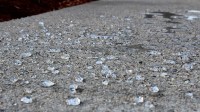Penetrating concrete sealers are designed to penetrate into the surface of the concrete where they chemically react without changing the look or color of the concrete, or leaving behind a surface film. Penetrating concrete sealers provide years of life and protection and require little to no maintenance.
The best penetrating concrete sealers to use on concrete are water repellent sealers. Water repellent sealers will repel water and other liquids, and prevent them from being absorbed into the concrete through the surface. Water repellent concrete sealers will help to reduce deterioration caused by water absorption and prevent cracking, spalling, and pitting. They will also help to reduce the formation of mold and mildew, algae, and efflorescence. While the bead will start to dissipate within the first 1-2 years, the sealer will continue to work for up to 10 years.
The best Penetrating Concrete Sealers under the water repellent sealer category are as follows:
- Armor SX5000 – Department-of-Transportation approved high solids Silane Siloxane water repellent sealer.
- Armor SC25 – Water based Siliconate water repellent sealer requiring only 1 coat.
How do water repellent sealers differ from Sodium or Lithium silicate Densifiers? A concrete Densifier will penetrate through the surface of the concrete to form a CSH (crystalline barrier) within the pores. Densifiers do not have water repellent abilities. While they will increase the strength and density of the concrete, they will not prevent or reduce deterioration caused by the absorption of water. Densifiers should only be used if you are looking to increase the strength of concrete, or reduce the movement of water/moisture through the pores. Water repellent sealers can be applied to concrete previously sealed with a concrete Densifier if water repellency characteristics are also required.
Can you use a water repellent/Densifier hybrid sealer? You can, but they aren’t as effective as using a Densifier first followed by a water repellent. The percentage of solids and active materials in a hybrid sealer will be significantly lower than what you would get if you used the products independently. The reactions will be weaker and the barriers formed smaller. Think of it this way. When you apply a silicate first you will end up with a breathable barrier than ranges from 1-4″ depending on the porosity of the concrete. The barrier will start at the surface and go down 1-4″. Then, when you apply a water repellent sealer the hydrophobic barrier will form in the vacant concrete pores, as well as between the gaps left by the CSH structure formed from the silicate. You get TWO very strong barriers throughout the entire 1-4″ of the concrete. If you apply a hybrid product, the hybrid product will penetrate 1-4″ as well, but the water repellent will form in some areas and the CSH will form in some areas. Each product will spread and there is no control over what forms and where. With a hybrid sealer you can expect an increase in strength of up to 25% (compared to 45% if you applied a silicate alone), and water repellency that lasts roughly 1-3 years (instead of the 10 years you would get if applied the water repellent alone).

